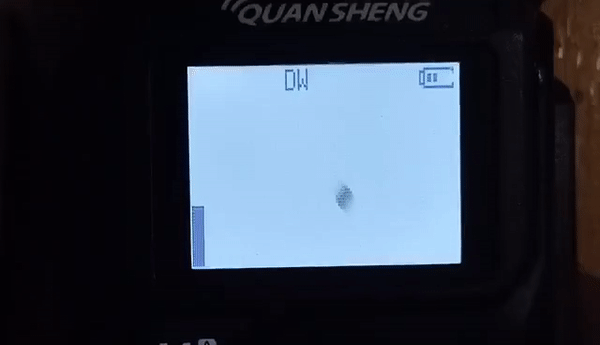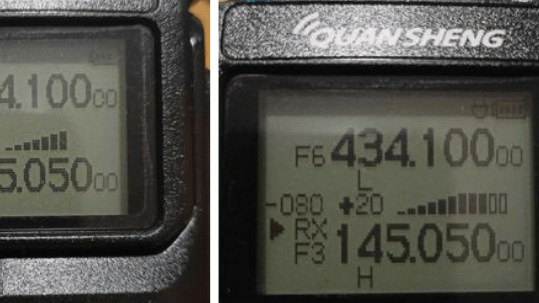Love them or hate them, the crop of cheap hand-held amateur radio transceivers is here to stay. They’re generally horrible radios, often smearing spurious emissions across the spectrum, but they’re cheap enough to throw in a glove box for emergencies, and they invite experimentation — for instance, modifying the firmware to add functionality the OEM didn’t think to offer.
 The new hotness in this class of radios is the Quansheng UV-K5, a two-band transceiver you can pick up for about $40, and we suspect it’ll get hotter still with this firmware trojan by [Piotr (SQ9P)]. We’ve already seen a firmware hack for these radios, one that aimed at unlocking the full frequency range of the RF chip at the heart of the radio. Honestly, we’re not huge fans of these mods, which potentially interfere with other allocations across multiple bands. But [Piotr]’s hacks seem a bit more innocuous, focusing mainly on modifying the radio’s display and adding useful features, such as a calibrated received signal strength bar graph and a numerical RSSI display. The really neat new feature, though, is the spectrum display, which shows activity across a 2-MHz slice of spectrum centered on the currently set frequency. And just because he could, [Piotr] put in a game of Pong.
The new hotness in this class of radios is the Quansheng UV-K5, a two-band transceiver you can pick up for about $40, and we suspect it’ll get hotter still with this firmware trojan by [Piotr (SQ9P)]. We’ve already seen a firmware hack for these radios, one that aimed at unlocking the full frequency range of the RF chip at the heart of the radio. Honestly, we’re not huge fans of these mods, which potentially interfere with other allocations across multiple bands. But [Piotr]’s hacks seem a bit more innocuous, focusing mainly on modifying the radio’s display and adding useful features, such as a calibrated received signal strength bar graph and a numerical RSSI display. The really neat new feature, though, is the spectrum display, which shows activity across a 2-MHz slice of spectrum centered on the currently set frequency. And just because he could, [Piotr] put in a game of Pong.
[Piotr]’s description of the mod as a trojan seems apt since his new programs run in parallel to the OEM firmware by wrapping its vector table. We’d imagine other mods are possible, and we’re keen to see what people come up with for these hackable little units. Just make sure you’re staying within the law, especially in the United States — the FCC does not play games (third item).

















Now to install DOOM!
Yes!
+1 ;)
“generally horrible radios, often smearing spurious emissions across the spectrum”
Yes….
But will work OK as single freq. monitor(ie, local fire chan,,,etc)
I use 2 for inputs to my old Sage EAS decoder(on WX freqs)
But please don’t TX with these!
+1
That’s a good point. Yes, I confirm, these handheld radios really do cover an notable frequency range! 🙂👍
Personally, though, I do rather use an FM scanner from the late 80s/early 90s for that purpose. There are nice desktop models by Uniden, for example. They are usually of better build quality than those cheap 21th century handheld radios.
These oldies have discreet FM decoder ICs or generously sized coils with a good Q factor (by comparison) and support 25 KHz channel spacing. In short, their digital parts may be outdated, but not the analog parts. That’s what makes the difference, maybe.
Alas, many ham radio fellows I know don’t get it. They insist on their Baofengs or 817s, because they religiously believe that modern tech always is better and can’t possibly be worse. No matter how often I told them to get a simple FM scanner as an auxiliary receiver they just don’t care (with a monitor receiver they could hear themselves on the repeater, useful to check modulation and to avoid transmitting at same time).
Meanwhile, I always have fun decoding APRS and SSTV from ISS by using vintage tech (Multimode on Mac, 486 retro PC with UI-View and PK-232 TNC), while the others for the sake of it can’t get things to work with their state-of-the-art tech). Originally, this made me smile, now I pity them. Poor fellows, such fools. 😔
To give you ab idea: They get on a hill and use directional antennas, yagis and won’t get it to work. I simply use an FM desktop scanner (25 KHz) with a telescope antenna, sitting on the couch in the living room, while recoding an SSTV signal from space. Anyway, each to his own. Some people simply can’t be helped. 🤷♂️
You can’t fix stupid!
I REALLY like your older scanner idea! Can you please give me details on exactly what I should look for & where to find one? I hope to get a set-up like yours, ASAP. Any advice would be greatly appreciated. TIA KD9KMY
It’s too bad the article begins with the malignment of Quandheng radios as “generally terrible”, since Quansheng makes the TG-UV2Plus (and TG-UV2), the only Chinese handheld that I’m aware of that uses a genuine superhet receiver circuitry, and as a result, has massively better noise rejection and receive sensitivity than all the various Baofeng, etc. radios that actually earn the “terrible” moniker.
I think the “terrible moniker” was due to the dirty transmit, not the receive.
It’s the transmit trash that’s the culprit, not the receiver. I haven’t seen anything that says ANY of the Chinese low cost handhelds aren’t terrible in that regard.
Old radios had used real FM.
Ist that also true for radios of the far east, too? Or do they use PM?
Let’s think about it for a moment..
Because, FM repeaters on 2m/70cm do use true FM. That’s why they’re called “FM repeaters” and not “PM repeaters”, after all. ;)
Now, if users with a PM “two-way radio” get on the FM repeater, their modulation may sound off. One of the reasons might be emphasis/de-emphasis?
Anyway, there are technical documents online that explain this matter way better than I possibly could.
And yet nobody ever provides evidence of true real world interference being caused. Also you can buy commercial radios for cheaper that transmit across an entire VHF or UHF band. Stop fear mongering over a “Ham radio” that’s open transmit.
The point is that it’s against the values of amateur radio to harm the environment. It should be avoided as much as possible. It’s an ethical principle, also. Ham themselves are the victims of RFI. Plasma TVs, power supplies, network cables, DSL/telephone lines etc. They all harm the radio spectrum below 30 MHz. So if hams don’t care about their own emissions, how can they (morally) stand above all of the other RF polluters ? Also, hams are pioneers. They were around since the early days of radio. Protecting radio technology as a whole should be their aim. Like monks who had saved knowledge and wisdom over the centuries. Hams are non-commercial, they aren’t being employed by any company or agency. They will outlive many of them.
The comments are a perfect example of what’s killing ham radio. No one wants to hear old people lecturing about how someone else should use old equipment because of a religious belief that the new stuff is “all junk”.
I must not have read the same comments you did. No one has argued that “new stuff” is bad, only that *these* cheap handhelds have dirty transmitted signals.
I dont care if they are junk radios due to “dirty transmission/harmonics etc. Had a bunch of handhelds/base stations ranging from 250 to as high as almost a thousand dollars but I see these modern cheap/junk radios as a game changer and as a valuable tool with SHTF scenarios. 15 to 20 years ago I am unable to buy 10+ sets of radios that can RX/TX on such wide range of frequencies for under $300. My point was proven after going thru 2 typhoons and one major blackout with no functioning mobile coverage. Handed out a bunch of preprogrammed fengs and a quick crash course on how to properly use the radios to all of my family members and neighbors and that is what keep us in touch with each other for almost 2 weeks. With SHTF scenarios who effin cares about regulations. My 2 cents.
If it wasn’t for Baofangs and other cheap Asian radios, HAMs would have nothing to talk about. Those 5 Watts of Chinese power not doing very much to harm the 1/2 mile of empty airways. BTW Hackaday… WTF? Your whole site is about voiding warranties. How many 802.11 access point mods have you promoted over the years? I am happy that the cult of the HAM wasn’t as vocal when the Internet hit its stride with Linksys 54G routers…
Who cares if a Baofang isnt perfect? HAM radio operators are encouraged to “build, DIY, experiment”. The real issue is Baofangs allow Americans that have not been initiated into the HAM community participate, and the HAMs think its unfair. No worries, the stats are clear, 60% of HAMs will be dead in about 10 years, and the airways will go from 95% crystal clear (empty) to 99% clear. God forbid new possible people are inspired by a Baofeng without taking a test. Imagine the Internet if Microsoft would have won in the early nineties, squashing that cancerous Linux, and forcing all to test and receive and MCSE before they could setup a web server! Dont encourage this HackADay. You are better than that!
Everyone should pickup a Baofeng for experimentation. We need to modernize our approach to Amateur Radio, Factually true. (please look it up) 70% of Ham operators are while men over the age of 65. So… Grab a radio, any radio, have some fun, innovate, and become inspired.
Think Linux v Microsoft.
Cable V Cord Cutting
CD’s vs MP3s
And yet, for all the nays, and yays, I haven’t seen anyone use the words “Service Monitor”. Everything else is BS until you test.
I am 14 hours into this radio with frequency analyzer mod and am finding it pretty useful for “recon” jumping around 2mhz ranges with a clearly visible squelch let’s you find frequencies of interest, even if I am going to punch those into my bearcat AT125 because the am decoding on the Quansheng is awful.